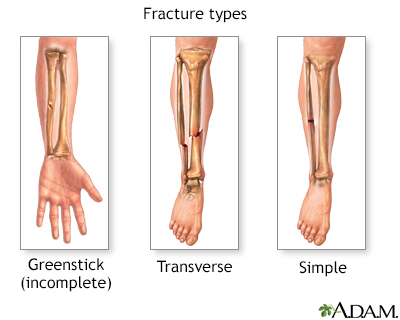Pregnancy SmartSiteTM
Bone - broken; Fracture; Stress fracture; Bone fracture DefinitionIf more pressure is put on a bone than it can stand, it will split or break. A break of any size is called a fracture. If the broken bone punctures the skin, it is called an open fracture (compound fracture). A stress fracture is a break in the bone that develops because of repeated or prolonged forces against the bone. The repeated stress weakens the bone until it finally breaks. ConsiderationsIt may be hard to tell a dislocated joint from a broken bone. However, both are emergency situations, and the basic first aid steps are the same. CausesThe following are common causes of broken bones:
SymptomsSymptoms of a broken bone include:
First AidFirst aid steps include:
CHECK BLOOD CIRCULATION Check the person's blood circulation. Press firmly over the skin beyond the fracture site. (For example, if the fracture is in the leg, press on the foot). It should first blanch white and then "pink up" in about 2 seconds. Signs that circulation is inadequate include pale or blue skin, numbness or tingling, and loss of pulse. If circulation is poor and trained personnel are NOT quickly available, try to realign the limb into a normal resting position. This will reduce swelling, pain, and damage to the tissues from lack of blood. TREAT BLEEDING Place a dry, clean cloth over the wound to dress it. If the bleeding continues, apply direct pressure to the site of bleeding. DO NOT apply a tourniquet to the extremity to stop the bleeding unless it is life threatening. Tissue can only survive for a limited amount of time once a tourniquet is applied. Do Not
When to Contact a Medical ProfessionalCall 911 or the local emergency number if:
Even though other broken bones may not be medical emergencies, they still deserve medical attention. Contact your health care provider to find out where and when to be seen. If a young child refuses to put weight on an arm or leg after an accident, won't move the arm or leg, or you can clearly see a deformity, assume the child has a broken bone and get medical help. PreventionTake the following steps to reduce your risk of a broken bone:
ReferencesGeiderman JM, Torbati S. General principles of orthopedic injuries. In: Walls RM, ed. Rosen's Emergency Medicine: Concepts and Clinical Practice. 10th ed. Philadelphia, PA: Elsevier; 2023:chap 41. Kim C, Kaar SG. Commonly encountered fractures in sports medicine. In: Miller MD, Thompson SR, eds. DeLee Drez & Miller's Orthopaedic Sports Medicine. 5th ed. Philadelphia, PA: Elsevier; 2020:chap 10. Whittle AP. General principles of fracture treatment. In: Azar FM, Beaty JH, eds. Campbell's Operative Orthopaedics. 14th ed. Philadelphia, PA: Elsevier; 2021:chap 53. | |
| |
Review Date: 2/8/2024 Reviewed By: Linda J. Vorvick, MD, Clinical Professor, Department of Family Medicine, UW Medicine, School of Medicine, University of Washington, Seattle, WA. Also reviewed by David C. Dugdale, MD, Medical Director, Brenda Conaway, Editorial Director, and the A.D.A.M. Editorial team. The information provided herein should not be used during any medical emergency or for the diagnosis or treatment of any medical condition. A licensed medical professional should be consulted for diagnosis and treatment of any and all medical conditions. Links to other sites are provided for information only -- they do not constitute endorsements of those other sites. No warranty of any kind, either expressed or implied, is made as to the accuracy, reliability, timeliness, or correctness of any translations made by a third-party service of the information provided herein into any other language. © 1997- A.D.A.M., a business unit of Ebix, Inc. Any duplication or distribution of the information contained herein is strictly prohibited. | |

 X-ray
X-ray Fracture types (1)
Fracture types (1) Fracture, forearm ...
Fracture, forearm ... Osteoclast
Osteoclast Fracture types (2)
Fracture types (2) External fixation ...
External fixation ... Fractures across a...
Fractures across a... Internal fixation ...
Internal fixation ...
